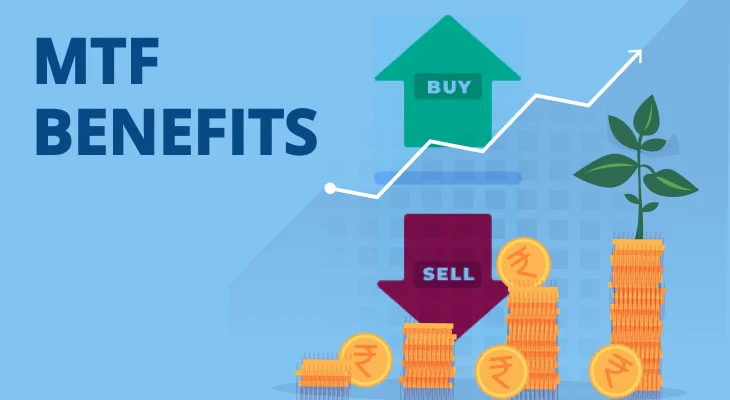Margin trading is a financial strategy that allows investors to amplify their market exposure by borrowing funds to trade. Margin trading facility (MTF) has gained popularity among traders looking to maximize their returns.
This article will delve into the intricacies of MTF, exploring how it works, its benefits, risks, and the regulatory framework governing it in India.
What is a Margin Trading Facility (MTF)?
A margin trading facility, as the name suggests, is a financial arrangement that enables investors to buy more securities than they can afford with their capital. Essentially, it involves borrowing funds to trade in the stock market, using the existing securities as collateral. In India, brokerage firms predominantly offer this facility, providing clients with the means to leverage their investments and potentially enhance their returns.
How Does Margin Trading Work?
Margin trades work on the principle of leveraging. When an investor opens a margin account with a brokerage, they can borrow funds to purchase additional securities beyond their cash balance. The securities held in the investor’s account act as collateral for the borrowed funds. The margin ratio, expressed as a percentage, determines how much an investor can leverage their capital.
For example, if an investor has Rs. 50,000 in cash and the margin ratio is 2:1, they can potentially trade with up to Rs. 1,00,000 (Rs. 50,000 of their own money plus Rs. 50,000 borrowed). This amplifies both potential gains and losses.
Benefits of Margin Trading Facility
Increased Buying Power- MTF allows investors to control a larger position in the market with a relatively smaller amount of their capital. This increased buying power can potentially lead to higher profits.
Diversification- Margin trading enables investors to diversify their portfolios by gaining exposure to a broader range of securities without needing the full capital amount.
Short-Selling Opportunities- MTF also allows investors to sell securities short, potentially profiting from the decline in prices. This provides an avenue for making money in a falling market.
Leveraged Returns- By using borrowed funds, investors can potentially achieve higher returns than they would with their capital alone, given the increased position size.
Risks Associated with Margin Trading
While the benefits of MTF are apparent, it comes with inherent risks that investors should be mindful of
Magnified Losses- Just as margin amplifies gains, it also magnifies losses. If the market moves against the investor, the losses could exceed the initial investment.
Interest Costs- Borrowed funds are not free. Investors must pay interest on the borrowed amount, impacting overall returns.
Margin Calls- If the value of the securities in the margin account falls below a certain level (maintenance margin), the brokerage may issue a margin call, requiring the investor to deposit additional funds or sell securities to cover the shortfall.
Market Volatility- Rapid and unexpected market movements can lead to substantial losses, especially if the investor has leveraged their position.
Regulatory Framework in India
In India, the Securities and Exchange Board of India (SEBI) regulates margin trading activities to ensure investor protection and market integrity. SEBI has implemented specific guidelines and risk management measures for brokers offering MTF services.
Initial Margin Requirements- SEBI mandates brokers to set initial margin requirements, which is the minimum amount of collateral an investor must have to enter into a margin trade. This helps mitigate the risk of default.
Risk-Based Supervision- Brokers are required to implement a risk-based supervision system to monitor the exposure of clients engaged in margin trading. This includes regular assessments of the financial health of clients and timely margin calls.
Leverage Limits- SEBI has set limits on the extent of leverage that brokers can offer to clients. This ensures that excessive leverage, which can lead to systemic risks, is avoided.
Disclosure and Investor Education- Brokers are obligated to educate their clients about the risks associated with margin trading and ensure that they fully understand the implications before engaging in such activities.
How to Choose the Best Margin Trading Facility App
Choosing the best margin trading facility app is crucial for a seamless and secure trading experience. Consider the following pointers when making your decision-
Regulatory Compliance- Ensure the app is regulated by relevant authorities to guarantee compliance with financial regulations and protect your interests.
User Interface- opt for an app with an intuitive and user-friendly interface for easy navigation and efficient trading execution.
Security Features- Prioritize apps with robust security features, including encryption and two-factor authentication, to safeguard your financial information.
Margin Requirements- Understand the app’s margin requirements, fees, and interest rates to assess the cost of leveraging and make informed trading decisions.
Research Tools- Look for apps that provide comprehensive research tools, real-time market data, and analysis to support your trading strategies.
Customer Support- Choose an app with responsive and accessible customer support to address any queries or concerns promptly.
Platform Stability- Select an app known for its reliability and minimal downtime to ensure a stable trading platform.
Educational Resources- opt for platforms that offer educational resources and tutorials, helping you stay informed and make strategic investment decisions.
One app that provides investors and traders with all the above benefits is m.Stock by Mirae Asset. Here are the reasons why the Mirae Asset capital market app is the best-
- m.Stock charges the lowest interest rates on margin trading. The rates range from 6.99% to 9.99%.
- The subscription charge on margin trading is zero.
- Traders are charged zero brokerage while using MTF.
- Traders can make a trade within 3 simple clicks.
- Traders can use the MTF calculator to understand their potential returns.
Margin Trading in the Financial Landscape
Margin trading facility can be a powerful tool for investors seeking to maximize their market exposure and potential returns. However, it comes with significant risks that should not be underestimated. In the Indian context, SEBI’s regulatory framework is crucial in ensuring responsible and transparent margin trading practices.
Investors considering margin trading should thoroughly understand the mechanics, risks, and regulatory guidelines associated with MTF. It is advisable to have a well-thought-out risk management strategy and to use margin cautiously, keeping in mind that while it can amplify gains, it can also amplify losses. As with any financial strategy, informed decision-making and a thorough understanding of the market dynamics are key to success in margin trading.













